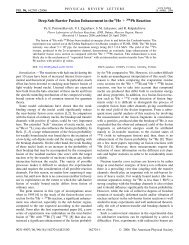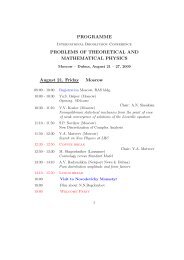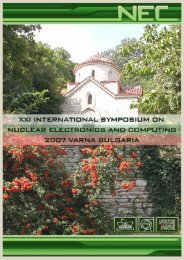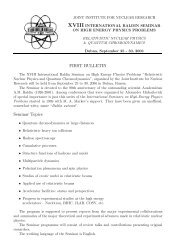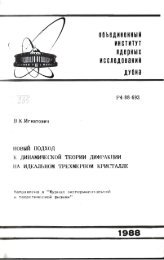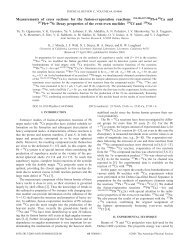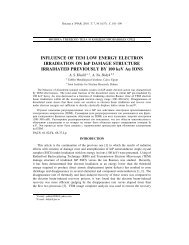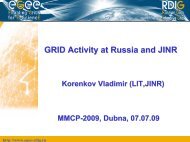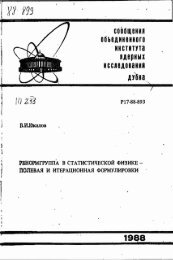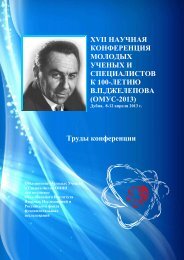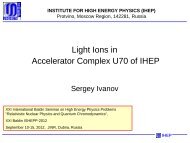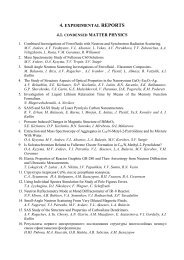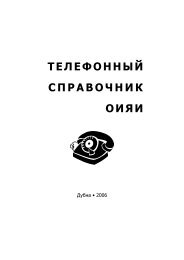Joint Institute for Nuclear Research Relativistic ... - Index of - JINR
Joint Institute for Nuclear Research Relativistic ... - Index of - JINR
Joint Institute for Nuclear Research Relativistic ... - Index of - JINR
You also want an ePaper? Increase the reach of your titles
YUMPU automatically turns print PDFs into web optimized ePapers that Google loves.
DEUTERONS BEAM PARAMETERS MEASUREMENTS OF THE NUCLOTRON<br />
K.Husak 1 , M.Artushenko 2 , I.Zhuk 1 , V.Voronko 2 , M.Kadykov 3 , A.Patapenka 1 , A.Safronava 1 ,<br />
V.Sotnikov 2 , S. Tyutyunnikov 3 , V.Chilap 4 , A.Chinenov 4<br />
1<br />
<strong>Joint</strong> <strong>Institute</strong> <strong>of</strong> Power and <strong>Nuclear</strong> <strong>Research</strong>-Sosny Minsk, Republic <strong>of</strong> Belarus<br />
2<br />
National Scientific Center Kharkov <strong>Institute</strong> <strong>of</strong> Physics and Technology Kharkov<br />
Republic <strong>of</strong> Ukraine<br />
3<br />
<strong>Joint</strong> <strong>Institute</strong> <strong>for</strong> <strong>Nuclear</strong> <strong>Research</strong>, Dubna, Russian Federation<br />
4<br />
CPTP “Atomenergomash”, Moscow, Russian Federation<br />
The experimental subcritical setup “QUINTA” irradiation by deuteron beams <strong>of</strong> energies 1, 4,<br />
6 and 8 GeV is described in the paper. The experiments were done in Laboratory <strong>of</strong> High<br />
Energy Physics (<strong>JINR</strong>, Dubna, Russian Federation). The beams were produced by<br />
superconducting, strong focusing synchrotron named Nuclotron.<br />
The experimental subcritical setup contains five sections. Each section is composed <strong>of</strong><br />
uranium rods arranged in the <strong>for</strong>m <strong>of</strong> hexagonal (triangular) lattice with pitch size <strong>of</strong> 3.6 cm.<br />
Whole setup contains total <strong>of</strong> 512.56 kg <strong>of</strong> natural uranium.<br />
The axis <strong>of</strong> the setup was aligned with beam axis with the help <strong>of</strong> the adjustable stand under<br />
the whole setup. The alignment <strong>of</strong> the beam center with the center <strong>of</strong> the setup was achieved<br />
by examining Polaroid films placed in front <strong>of</strong> the target and exposed to a couple deuteron<br />
pulses prior to the installation <strong>of</strong> the sample plates and the start <strong>of</strong> the main irradiation.<br />
Deuteron's beams shape and position on the target were obtained from track density<br />
distribution on the irradiated track detectors. Sensors made <strong>of</strong> nat Pb foils and artificial mica as<br />
solid state nuclear track detectors (SSNTD) were used <strong>for</strong> registration Nat Pb(d,f) reaction. The<br />
coordinates <strong>of</strong> the deuteron beam centre and full width at half maximum <strong>of</strong> the distributions<br />
were obtained from the Gaussian fits <strong>of</strong> the deuteron beam in X- and Y-axis. The fraction <strong>of</strong><br />
the beam striking the fissionable material and number <strong>of</strong> deuterons gone out <strong>of</strong> the setup were<br />
calculated.<br />
The results obtaining during the experiments were used to determine beam position on the<br />
target, beam parameters (beam shape and beam size).<br />
It is shown that more precise primary alignment <strong>of</strong> the target along the beam axis is needed.<br />
Or, if it is not possible, the central part <strong>of</strong> the setup (uranium rods, d=3,6 cm) should be<br />
replaced by a lead target with bigger diameter, in order to avoid beam losses in the gaps<br />
between the rods.<br />
The simulations <strong>of</strong> the experiment were done with a FLUKA2011 Monte-Carlo code.<br />
Comparison experimental results and simulation is also presented.<br />
60



